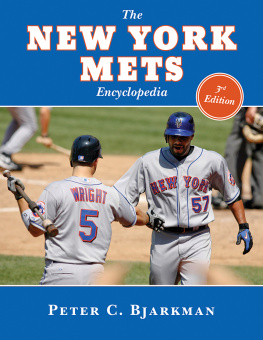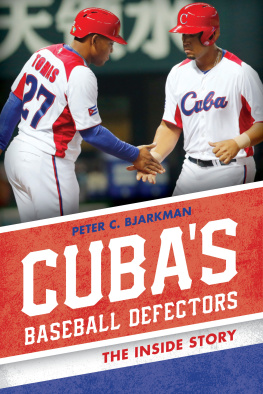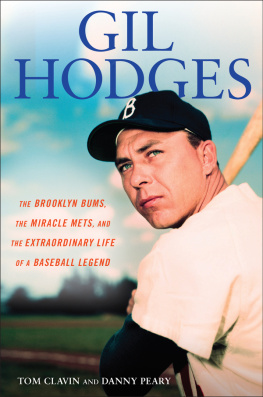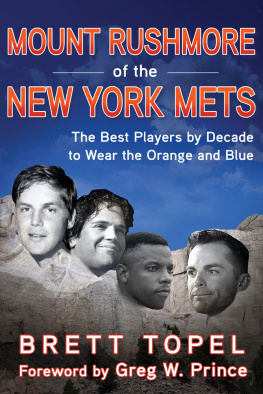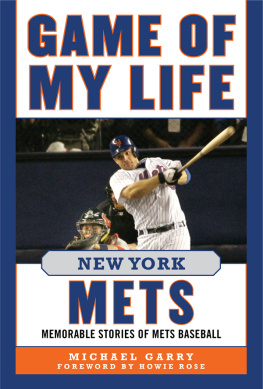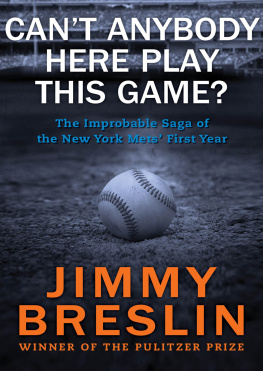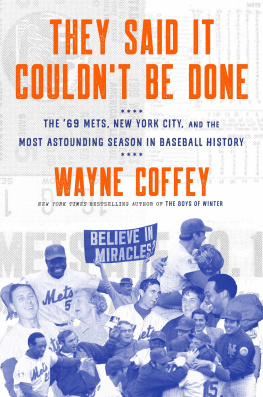THE
New York Mets
ENCYCLOPEDIA
Third Edition
THE
New York Mets
ENCYCLOPEDIA
Third Edition
PETER C. BJARKMAN

Copyright 2013 by Peter C. Bjarkman
All Rights Reserved. No part of this book may be reproduced in any manner without the express written consent of the publisher, except in the case of brief excerpts in critical reviews or articles. All inquiries should be addressed to Sports Publishing, 307 West 36th Street, 11th Floor, New York, NY 10018.
Sports Publishing books may be purchased in bulk at special discounts for sales promotion, corporate gifts, fund-raising, or educational purposes. Special editions can also be created to specifications. For details, contact the Special Sales Department, Sports Publishing, 307 West 36th Street, 11th Floor, New York, NY 10018 or sportspubbooks@skyhorsepublishing.com.
Sports Publishing is a registered trademark of Skyhorse Publishing, Inc., a Delaware corporation.
Visit our website at www.sportspubbooks.com
10 9 8 7 6 5 4 3 2 1
Library of Congress Cataloging-in-Publication Data is available on file.
ISBN: 978-1-61321-344-5
Printed in China
Contents
INTRODUCTION
The Miracle Mets
I n the final campaign of the 20th century, the newly minted Arizona Diamondbacks reached baseballs postseason pinnacle (as National League West Division champs) in only their second year of existencea record for quick success and unexpected overachievement not likely to be surpassed in baseballs foreseeable future. Arizonas arrival at the top of the pecking order with 100 victories in franchise year two came considerably faster than that of the Florida Marlins (world champions in their fifth season) or Colorado Rockies (wild-card winners in their third season), other recent expansion clubs boasting high-octane marches to respectability. But such overnight successes in Phoenix, Denver and Miami cannot justifiably be compared with other baseball achievements during most of the century. The baseball world of the nineties, with its thin talent pools and constant roster shifts, is not measurable against a baseball scene that existed before free-agency and rampant franchise expansion changed everything and tarnished many of the games cherished milestones and traditional modes of operation. New Yorks beloved Metsborn during the first wave of league expansion in the early 1960swere, for an earlier and far more stable baseball universe, unchallenged as the sports greatest-ever expansion success story. And by all reasonable measures they still remain so.
The New York Mets still provide one of baseballs most glamorous sagas of the modern age. In an era when dynasty teams like the National League Pirates, Cardinals, and Reds, and American League Oakland As and Baltimore Orioles still reigned supreme season after season, the lowly New Yorkers lost 100 or more and lived in the league basement for five of their first six campaigns, then shocked the baseball world with a near-30-game turnaround and miracle championship in only their eighth season of existence. It was an unprecedented feat at the time, and remains one of the games most remarkable rags-to-riches stories. These woebegone Mets, who launched their history as one of baseballs most consistent losers, were, at the same time, also one of Americas most beloved professional sports teams. This was especially true even before the dual miracles of 1969 and 1973, when New Yorks cherished team twice unpredictably sprung from worst to first in the seeming flash of an eye.
Some of baseballs most legendary moments of the past six decades belong to New Yorks 50-year-old National League ball club. There are still no more loveable losers found anywhere in the games annals than the inaugural New York squad of 1962, when expansion first came to the senior circuit and left New Yorkers with a bungling, rag-tag outfit that set countless new standards for epic losing and inept performance. The miracle pennant and world title of 1969 remains even today the national pastimes most memorable tale of altogether unlikely success. And there are other matching sagas through the years that also sound a memorable nostalgic note. There is manager Casey Stengels stoic tomfoolery, which made an entertaining circus of daily losing. There was the dramatic rebuilding of Mets fortunes in the wake of the tragic death of original miracle worker Gil Hodges. There were the glorious half a dozen seasons of the mid-eighties that witnessed the record winning of manager Davey Johnson and the meteoric rise of pitching phenom Dwight Gooden. And there was the late-1990s resurgence to prominence under manager Bobby Valentine, spiced by one of baseballs most fearsome modern-day lineups and by the short tenure of perhaps the best defensive infield in modern baseball history.
The Mets also hold their own for colorful and legendary ballplayers and managers. Tom Seaver was the first true franchise star and easily one of the most dominant pitchers of the late 20th century. Casey Stengel has no parallel in the lineage that stretches from John McGraw and Connie Mack to Sparky Anderson and Tony La Russa when it comes to baseballs most enigmatic and beloved Hall of Fame managers. Gil Hodges was one of the most idolized ballplayers in New York City in the decade before the Mets were born (the decade that also featured Mantle and Snider and Mays) and then won countless new hearts as a dedicated manager who worked true early-expansion miracles. Marvelous Marv Throneberry earned more lasting notoriety in a shorter time span and for fewer on-field accomplishments than perhaps any figure in the history of the national pastime. Slow-footed slugger Rusty Staub was a workingmans franchise hero of a most unpredictable cut when it comes to ballplaying legends. Flaky southpaw Tug McGraw not only keyed a World Series drive but coined the memorable phrases that captured an entire giddy era of New York Mets history. Dwight Doc Gooden was perhaps not only the most memorable tragic hero of Mets annals, but also one of the biggest talent-laced phenoms and simultaneously one of the biggest washouts of the last several big league decades. And in more recent epochs, there was also the incomparable Mike Piazza, a big-muscled slugger who thrilled pre-millennium Shea Stadium partisans while on his personal road to glory as baseballs all-time best-hitting catcher.
The following pages recount the full saga of the always lovable, sometimes laughable, and often glamorous New York Mets. The New York Mets Encyclopedia, Third Edition provides the complete and exciting account of modern baseballs most popular expansion franchise. From those lovable basement-dwelling losers of 1962 and 1963 to the champion Miracle Mets of 1969 and 1973 to the year-in and year-out contenders of the 1980s, 1990s, and 2000s, New Yorks National League Mets have written some of the most exciting and colorful pages in modern major league history. This is the team that captured the hearts of New Yorkers and ball fans everywhere with their well-documented high jinks under double-talking manager Casey Stengel, then only half a dozen years later climbed straight to baseballs pinnacle under gifted yet ill-fated manager Gil Hodges. The irrepressible Stengel provided the necessary first doses of notoriety and utility infielder Don Zimmer was only the first of many to note that perhaps nobody would have paid the least notice to the earliest editions of the Mets had it not been for the impish behaviors of manager Stengel. Hodges was in turn responsible for the sudden dose of nobility which overnight descended upon baseballs most surprising rags-to-riches winners.
Next page
